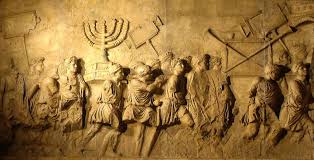The tearing of the Temple veil at the moment of Jesus’ death marked a profound transition in human history. It signified the fulfillment of all Old Covenant prophecies, sacrificial requirements, and priestly functions in the death, burial, and resurrection of Christ. While the physical destruction of the Temple in 70 A.D. and the 40-day post-resurrection appearances of Jesus are historically significant, they hold no theological weight regarding the fulfillment of prophecy. Instead, they serve as symbolic confirmations of the spiritual reality already completed at the cross.
This article explores the historical and theological context of events in the Temple following the crucifixion, the inconsistencies of post-resurrection timelines, and the importance of recognizing the finality of Jesus’ sacrifice as the fulfillment of all scripture.
The Talmud’s Account of Changes in the Temple After the Crucifixion
The Talmud (Yoma 39b) provides a fascinating historical record of unusual occurrences in the Jerusalem Temple, beginning around 30 A.D., the approximate time of Jesus’ crucifixion, and continuing until its destruction in 70 A.D. These anomalies include:
1. The Lot for the Scapegoat:
• On Yom Kippur (Day of Atonement), the high priest would cast lots to determine which goat would be sacrificed to the Lord and which would be the scapegoat carrying away the sins of Israel (Leviticus 16:8-10).
• Traditionally, the lot for the Lord would appear in the right hand, symbolizing God’s acceptance of the ritual. However, for the 40 years leading up to the Temple’s destruction, the lot consistently appeared in the left hand, a sign of rejection.
2. The Crimson Thread:
• A crimson thread tied to the scapegoat or the Temple door would miraculously turn white, symbolizing the forgiveness of sins (Isaiah 1:18: “Though your sins are like scarlet, they shall be as white as snow”).
• For 40 years before the Temple’s destruction, the thread ceased turning white, signifying that the sacrifices were no longer accepted by God.
3. The Westernmost Lamp:
• In the Temple’s Menorah, the westernmost lamp was supposed to remain lit as a sign of God’s presence. For 40 years before the Temple’s destruction, this lamp repeatedly went out, symbolizing God’s departure.
4. The Temple Doors:
• The doors of the Temple would mysteriously swing open on their own, an ominous sign interpreted as the impending judgment of the Temple.
These events, beginning at the time of Jesus’ crucifixion, align with the New Testament teaching that His death fulfilled the sacrificial system, rendering the Temple obsolete (Hebrews 10:10-18).
The Crucifixion Fulfilled All Scripture
In Luke 24:44-45, Jesus makes a definitive statement about His death, burial, and resurrection:
“These are my words that I spoke to you while I was still with you, that everything written about me in the Law of Moses, the Prophets, and the Psalms must be fulfilled.”
This declaration establishes that:
1. Jesus’ sacrifice fulfilled every prophetic promise, including judgment, atonement, and reconciliation with God.
2. No future events—whether the Temple’s destruction in 70 A.D. or the 40 days of post-resurrection appearances—add to this fulfillment.
The tearing of the veil at His death (Matthew 27:51) symbolized the end of the Old Covenant and the complete reconciliation between God and humanity. This shift was not gradual or progressive; it was immediate and total.
The 40 Days After the Resurrection: Historical but Not Prophetic
The Gospel accounts and Acts provide varying timelines for Jesus’ post-resurrection appearances:
• John 20:17 suggests Jesus ascended on the evening of His resurrection.
• Luke 24:51 implies an ascension on the same day.
• Acts 1:3 states that Jesus appeared for 40 days before ascending.
This lack of consistency raises questions about the centrality of the 40-day period. While Acts highlights this timeframe, it does not appear in Paul’s writings or other epistles, which emphasize the finished work of Christ. Paul’s gospel focuses exclusively on the cross and resurrection as the fulfillment of all prophecy (1 Corinthians 15:3-4).
Implication: The 40-day period served as a transitional moment for the apostles to grasp the reality of Jesus’ resurrection. However, it does not hold theological significance for the fulfillment of prophecy, nor does it validate Peter or the early apostles as central figures in the New Covenant. The true revelation of the gospel came later, through Paul, who declared himself the exclusive recipient of the mystery hidden for ages (Ephesians 3:8-9).
The Destruction of the Temple in 70 A.D.: Symbolic but Not Prophetic
The physical destruction of the Temple in 70 A.D. is often cited as a fulfillment of prophecy, particularly Jesus’ words in Matthew 24:2: “There will not be left here one stone upon another that will not be thrown down.” However:
1. Matthew 24 describes the transition from the Old Covenant to the New, fulfilled in Jesus’ death and resurrection.
2. The Temple’s destruction was not a prophetic necessity but a historical event that symbolized what had already occurred spiritually in 30 A.D.
By 70 A.D., the Temple sacrifices had been meaningless for 40 years, as evidenced by the anomalies recorded in the Talmud. The destruction only confirmed the obsolescence of the Old Covenant system, which had already been replaced by the New Covenant in Christ’s body (Hebrews 9:11-12).
Key Point: There cannot be two concurrent temples—Christ, the resurrected body, and the physical Temple in Jerusalem. Jesus’ death fulfilled all sacrificial and covenantal requirements, rendering the Temple irrelevant.
Paul’s Exclusive Revelation of the Gospel
Paul emphasizes that the mystery of the gospel was revealed only to him:
• Ephesians 3:8-9: “To me, though I am the very least of all the saints, this grace was given, to preach to the Gentiles the unsearchable riches of Christ, and to bring to light for everyone what is the plan of the mystery hidden for ages in God.”
• Galatians 1:11-12: “For I did not receive it from any man, nor was I taught it, but I received it through a revelation of Jesus Christ.”
Paul’s writings exclude the need for post-resurrection appearances, a continuing priesthood, or the destruction of the Temple as essential elements of the gospel. Instead, he declares the death, burial, and resurrection of Jesus as the fulfillment of all prophecy.
Conclusion: The Cross as the Fulfillment of All Things
The events following the crucifixion—the anomalies in the Temple, the 40-day appearances, and the destruction of the Temple in 70 A.D.—serve as symbolic confirmations of the spiritual reality already accomplished at the cross. These events, while historically significant, hold no theological value in terms of fulfilling prophecy. Jesus Himself declared that His sacrifice fulfilled everything written in the Hebrew Scriptures (Luke 24:44-45).
To place prophetic significance on these events undermines the centrality and finality of the cross. As Paul emphasizes, the gospel is the mystery revealed in Christ, and no subsequent event can add to what was completed in His death, burial, and resurrection. The New Covenant, established in His body, rendered all other systems, sacrifices, and prophecies moot.
Michael Lilborn Williams
gospelrevolution.com


Thank you, Michael. You have convincingly placed preterism in it’s proper perspective. Much credit to you for addressing this subject.
Great explanation. “…symbolic confirmations of the spiritual reality already completed at the cross.”
Thank you Michael…I just can’t say it enough I love that you wrote this out.
thank you Mike for this